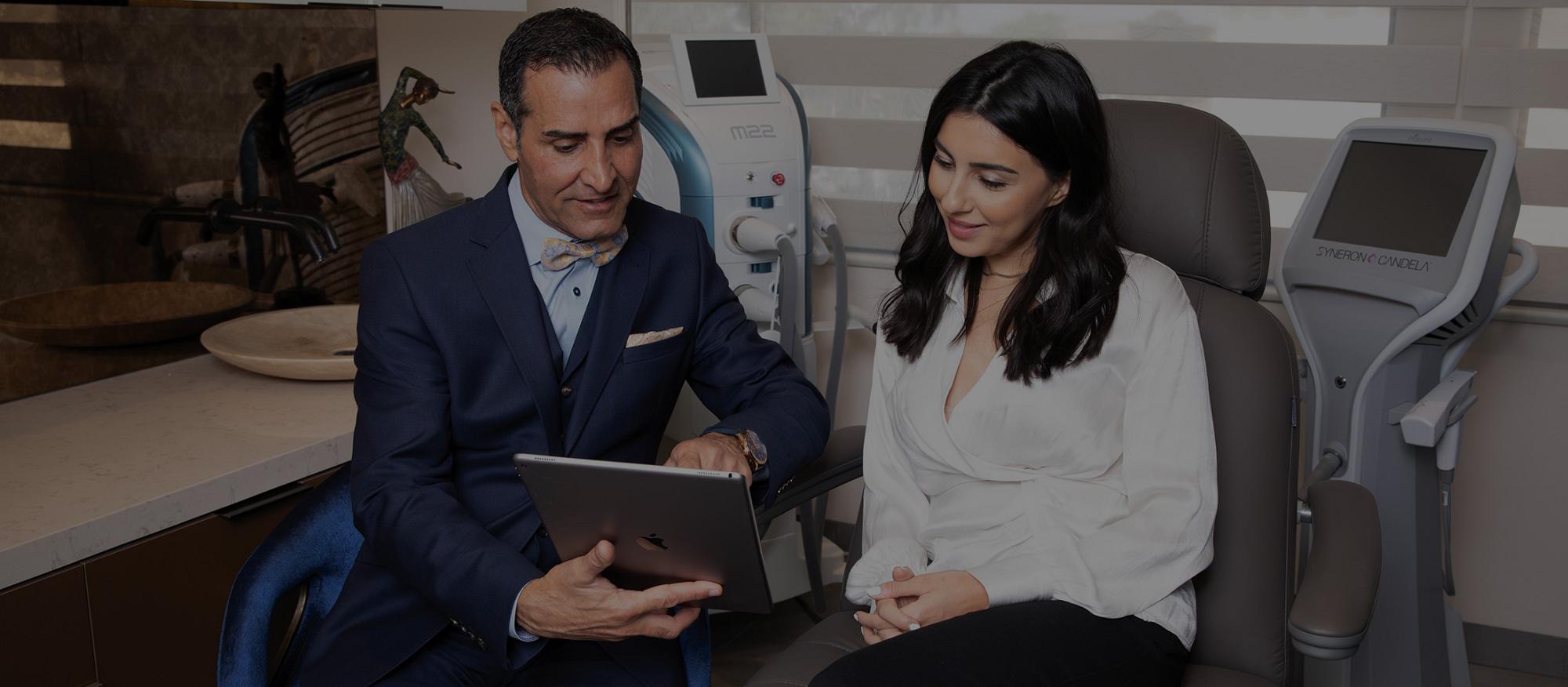


















You’re weighing the decision to have surgery, or maybe it’s already on your calendar, and what’s circling in your mind isn’t fear of the procedure, it’s the days and weeks after. It’s the worry about seeing friends, showing up for meetings, or just stepping outside when your face is swollen or bruised. It’s the discomfort of knowing you won’t look like yourself right away, and the uncertainty of how long it’ll last.
Here’s the reality: your recovery doesn’t have to drag on. And it definitely doesn’t have to be something you just endure. At our practice, we offer a Rapid Recovery Program designed to help you get back to your life faster and with less hassle. Not because it sounds impressive, but because it works.
Ask Dr. Sadati
Traditionally, patients were told to just rest, ice, and wait it out. But that plan ignores what modern science knows: the body wants to heal—it just needs the right tools. Without them, swelling lingers, bruises stick around, and scars can stay raised or red for longer than they should.
A facelift that could look great in three weeks might look rough until week six if swelling and inflammation aren’t managed. It’s not about shortcuts; it’s about giving your body what it needs to do the job better.
The Three Stages Of Recovery
This program isn’t a one-size-fits-all magic wand. It’s a combination of therapies chosen because they tackle specific issues that slow healing. Here’s what that looks like in practice:
Hyperbaric Oxygen Therapy (HBOT)
Here’s where theory meets experience: most patients don’t come back raving about what their collagen’s doing—they tell us how they felt walking into a meeting 10 days post-op with only a little concealer, or how they got on Zoom without a filter two weeks after surgery. They notice swelling dropping day by day. They sleep better because they’re not uncomfortable. They feel clear-headed and energetic instead of groggy for weeks.
It’s those real moments where you’re back to work, social events, or just your daily routine without everyone asking, “Are you okay?” that define a good recovery.
Recovery Protocol
Not all facelifts demand the same downtime, and understanding the differences can help you make a choice that fits your life and goals.
Offers the shortest recovery, often around 5-10 days before you feel comfortable seeing friends or returning to work. But this approach isn’t right for everyone; it only addresses mild sagging and doesn’t correct deeper structural issues.
Involves lifting the deeper supportive layers of the face. Recovery typically takes 10-15 days before most bruising and swelling subside. The results can appear natural, but they don’t always last as long or achieve the comprehensive rejuvenation that some patients desire.
The next generation of Deep Plane Facelifts delivers the most transformative and longest-lasting outcome by releasing and repositioning deeper facial ligaments. Recovery can take 2 to 3 weeks before you’re fully back to social activities. While the wait is longer, most feel the improvement is worth it.
Ultimately, recovery times vary person to person. Factors like your age, health, genetics, and commitment to aftercare all play a role in how quickly you’ll heal—and how soon you’ll feel ready to face the world again. With Rapid Recovery, we see many patients look noticeably better 30 to 40% faster. It’s not a promise of instant perfection. Healing is still healing. But it’s a measurable difference you’ll feel and see.
Recovery isn’t just cosmetic. Prolonged swelling can increase discomfort, tightness, or even the risk of complications like poor scar healing. Managing inflammation proactively can help you look better sooner, and it can also make your final results smoother and more predictable.
And yes, this program applies whether you’re having a preservation facelift or a smaller procedure. Because the fundamentals of good healing don’t change.
Surgery is a big decision. You’re putting time, money, and trust into your results. A recovery plan that helps you feel better physically and confident socially should be part of that investment. It’s how you get the most out of your surgery.
You’ve already chosen to do something for yourself. The right recovery program helps you enjoy the benefits sooner and with fewer worries. And if you have questions, we’re here to answer them honestly. No fluff, no false promises.
The most effective way is a structured aftercare plan: rest with your head slightly elevated, avoid smoking or alcohol, follow your surgeon’s medication instructions, and incorporate therapies like hyperbaric oxygen, LED light therapy, and lymphatic drainage massages. These all reduce swelling, boost circulation, and support faster healing.
Skip strenuous exercise, smoking, alcohol, salty foods (which can cause swelling), and anything that raises blood pressure too much in the first few weeks. Sleeping flat or on your stomach can also delay healing.
Most patients feel comfortable seeing friends or going out publicly by two weeks post-op, depending on swelling and bruising. Full healing and scar maturation can take up to 6 months, but the majority of visible recovery happens early.
Learn more about our Preservation Facelift →
Yes. Clinical studies show it enhances oxygen delivery to tissues, which can dramatically reduce bruising, accelerate healing, and minimize inflammation. Many patients report looking “weeks ahead” in their recovery after a few sessions.
Completely normal. Swelling can fluctuate for weeks after surgery, often worse in the mornings or after salty meals. Gentle lymphatic drainage and sleeping with your head elevated can help.
While they can’t erase scars, therapies like LED light and hyperbaric oxygen can improve wound healing, reduce redness faster, and minimize thick or raised scars. Keeping incisions clean and protected is key.
Many return to desk jobs within 10 to 14 days, especially if swelling is mild and makeup can be used. Those in more public-facing roles might want closer to three weeks.
It’s best to avoid air travel for 10 days. Flying too soon can increase swelling, discomfort, and the risk of complications. Discuss with your surgeon, especially if you’re traveling from out of town.

359 San Miguel Dr, Suite 200, Newport Beach, CA 92660
Clients from around the globe travel to see Dr. Sadati for his surgical expertise. He and his surgical team provide the highest standard of patient care, from the initial consultation, to complete recovery and conclusion of your care. Our friendly staff is available to accommodate you in any way that we can.
What procedure are you interested in?
359 San Miguel Dr, Suite 200, Newport Beach, CA 92660
What procedure are you interested in?